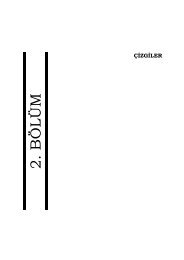Welding symbols on drawings - .:YUSUF MANSUROGLU - P
Welding symbols on drawings - .:YUSUF MANSUROGLU - P
Welding symbols on drawings - .:YUSUF MANSUROGLU - P
You also want an ePaper? Increase the reach of your titles
YUMPU automatically turns print PDFs into web optimized ePapers that Google loves.
2 The advantages of <str<strong>on</strong>g>symbols</str<strong>on</strong>g><br />
When it is required to indicate a weld <strong>on</strong> a drawing, it may seem<br />
that the weld can simply be drawn as it will appear. In the majority<br />
of cases, symbolic representati<strong>on</strong> can be used to cut down the time<br />
needed to complete the drawing and improve clarity.<br />
To save time in drawing the edge preparati<strong>on</strong> for a butt/groove<br />
weld or the shape and size of a fillet weld, a set of weld <str<strong>on</strong>g>symbols</str<strong>on</strong>g><br />
can be used. These <str<strong>on</strong>g>symbols</str<strong>on</strong>g> are placed <strong>on</strong> a horiz<strong>on</strong>tal reference line.<br />
This line is attached to an arrow line which points to the locati<strong>on</strong><br />
of the weld (see Fig. 2.1). In the ISO system there are two parallel<br />
reference lines, <strong>on</strong>e solid and <strong>on</strong>e dashed. In the AWS system a solid<br />
reference line is used.<br />
ISO AWS<br />
Arrow line<br />
Solid reference line<br />
Dashed reference line<br />
Tail Arrow line<br />
Solid reference line<br />
Tail<br />
2.1 ISO and AWS reference lines and arrow lines.<br />
Apart from weld <str<strong>on</strong>g>symbols</str<strong>on</strong>g> placed <strong>on</strong> the reference line, additi<strong>on</strong>al<br />
informati<strong>on</strong> can be supplied adjacent to the tail which is generally<br />
omitted when not required.<br />
The arrow line can point in any directi<strong>on</strong> as shown in Fig. 2.2.<br />
This is so that it can locate welds in any welding positi<strong>on</strong>, for<br />
example flat or overhead. The arrow line is never drawn horiz<strong>on</strong>tally<br />
because this would make it appear to be a c<strong>on</strong>tinuati<strong>on</strong> of the<br />
reference line, which is always horiz<strong>on</strong>tal.<br />
ISO AWS ISO<br />
2.2 Possible directi<strong>on</strong>s in which arrow lines may point.<br />
It is c<strong>on</strong>venti<strong>on</strong>al practice to refer to the opposite sides of a<br />
welded joint as the arrow side and the other side (see Fig. 2.3).<br />
(a)<br />
AWS<br />
ISO<br />
Other side Arrow side Arrow side<br />
(b)<br />
AWS<br />
Other side<br />
2.3 The arrow side and other side of a T-joint (a) and a<br />
butt/groove joint (b).<br />
The advantages of <str<strong>on</strong>g>symbols</str<strong>on</strong>g> 3



